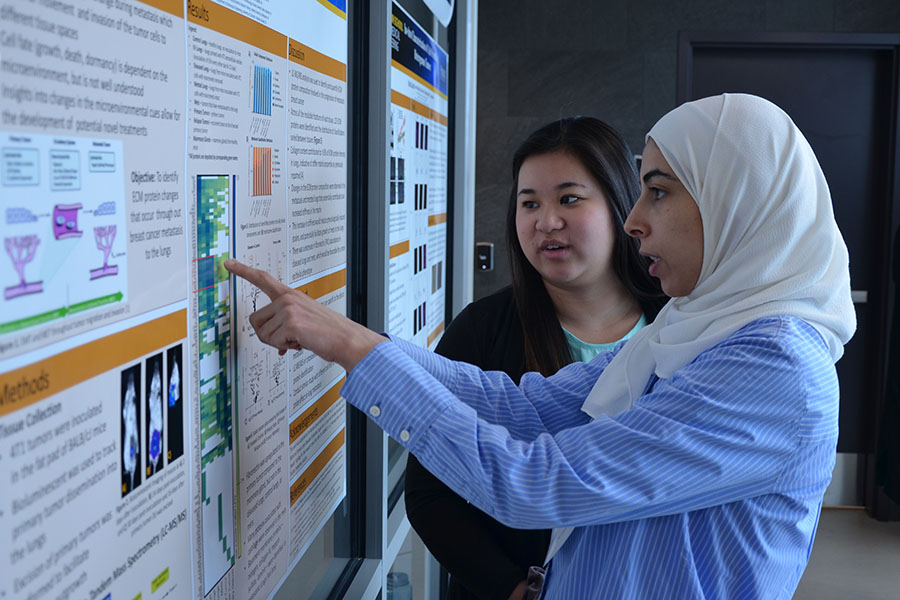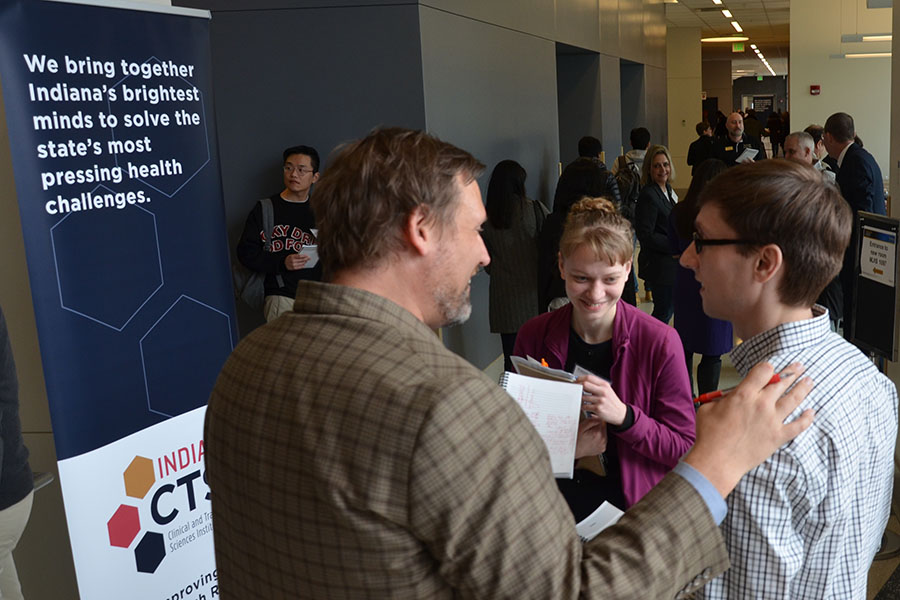Purdue University hosts record-breaking Indiana CTSI Retreat
The theme of the event was “Engineering Giant Leaps in Medicine,” as an homage to Purdue’s College of Engineering alumnus Neil Armstrong, and to reflect the institution’s bold and growing efforts to transform healthcare. The overarching goal of the event was to connect life science investigators in emerging technical areas around clinical needs in order to spur creative ideas and new engineering approaches.
George Wodicka, Dane A. Miller Head of Biomedical Engineering at Purdue University and co-director of the Indiana CTSI, noted the tremendous size and scope of the event and attendance of many investigators from Purdue, Indiana University School of Medicine, and Notre Dame. “The palpable excitement here today gives me a strong sense that the best is yet to come, as we increase the collective scale of our capabilities to improve healthcare,” he said.
Bruce J. Tromberg, director of the National Institute of Biomedical Imaging and Bioengineering (NIBIB), National Institutes of Health, gave the keynote address in Jischke Hall’s new Innovation Wing. Tromberg’s plenary talk highlighted the history of the formation of the institute and as well as burgeoning opportunities in the field.

The event’s strong attendance reflects the recent boom in the life sciences industry in Indiana. Nearly 2,000 life sciences companies are now based in Indiana, from pharmaceutical, such as Eli Lilly and Company, to medical devices, such as Cook Group. The statewide impact of this sector approaches $80 billion, including $10 billion in product exports.
Wodicka acknowledged the broad support of Indiana’s life sciences sector from federal agencies, such as the NIH, private foundations, such as Lilly Endowment and the Regenstrief Foundations, as well as state-supported research and clinical initiatives.
“At the very heart of these efforts are the unique collaborations of our academic institutions that are collectively the ‘difference-makers’ through their talent development, idea generation, technology translation, and company support,” Wodicka said.

The Indiana CTSI is an integrative force for partnerships and collaborations across the State. The NIH-supported institute represents the State’s premier research institutions, Indiana University, including Indiana University School of Medicine, the University of Notre Dame, and Purdue, and bridges the academic institutions to healthcare providers such as IU Health and hospital partners statewide. It facilitates connections with life science companies to meet workforce and technical needs, as well as supports research infrastructure to help proposal discoveries into new medical approaches. It establishes and develops inter-institutional training and research programs that leverage the complementary nature and missions of the participating universities.
Theresa Mayer, executive vice president for research and partnerships at Purdue, said at the event, “This is thrilling to see how many participants we have. It really goes to show how many opportunities we have within the State of Indiana in this very important field of healthcare at the intersection of engineering.” Mark Lundstrom, acting dean of the Purdue College of Engineering added, “These are exciting times at Purdue and in Engineering. We are one of the largest programs in the nation. In a few years we’ll be nearly 500 faculty, 10,000 undergraduates, 5,000 graduate students, and 10,000 online students. But, we aim to be much more than a large, good, affordable program. We aim to be an example of excellence at scale.”
Mayer spoke of the strength of the strength of collaboration between the Indiana CTSI universities and significant investments that Purdue has made in the life sciences and other strategic investments in capital infrastructure, facilities, and faculty in the past five years.
“As a result of those strategic investments over the same period of time, Purdue has seen more than a doubling of investments from NIH; the CTSI is a critical part of that,” she said. Mayer expressed hope that these investments will continue to expand the range of opportunities within the life sciences industry and Purdue’s vibrant life sciences startup ecosystem.



The Weldon School of Biomedical Engineering at Purdue has been a programmatic component of the Indiana CTSI since its inception. According to Wodicka, the CTSI Biomedical Engineering program has shepherded 250 projects through technology development stages from design and benchtop testing through preclinical studies and transfer to company partners.
“Technology licenses have both spurred company growth, provided job opportunities for our graduates, generated royalty streams, and directly helped millions of patients worldwide,” he said. “These achievements continue to fuel the expansion in biomedical engineering of not only the faculty, but also students at all levels,” he said.
The school has recently undergone an $18M facilities expansion, and attendees were given the opportunity to tour the new Wing during the event’s thematic poster session that crowded the expanded building’s ground floor, stretched up to the second and third floor halls, and filled a conference room. The posters were themed around eight impact areas that address some of today’s most pressing healthcare needs: drug and substance abuse, musculoskeletal health, hearing loss and other degenerative diseases, infectious diseases, brain health and function, diabetes and cardiovascular disease, technology and healthcare, and cancer and development disorders. The students represented many multidisciplinary teams integrating diverse expertise in engineering and medicine to improve health and combat disease.
“This really has energized our students, because they see they’re entering fields where translational research is directly applicable to existing clinical needs,” said Wodicka.
The afternoon was dedicated to parallel engineering and clinical breakout sessions that provided an opportunity for participants to match clinical needs with technological solutions. Each session was attended by 50-100 researchers and clinicians. The engineering sessions were in the emerging areas of wearable technologies, point-of-care diagnostics and treatment, healthcare data connectivity, and personalized medicine and precision health. The clinical sessions focused on areas of critical healthcare needs in pediatrics, cardiovascular and metabolic diseases, oncology, substance use disorder.


